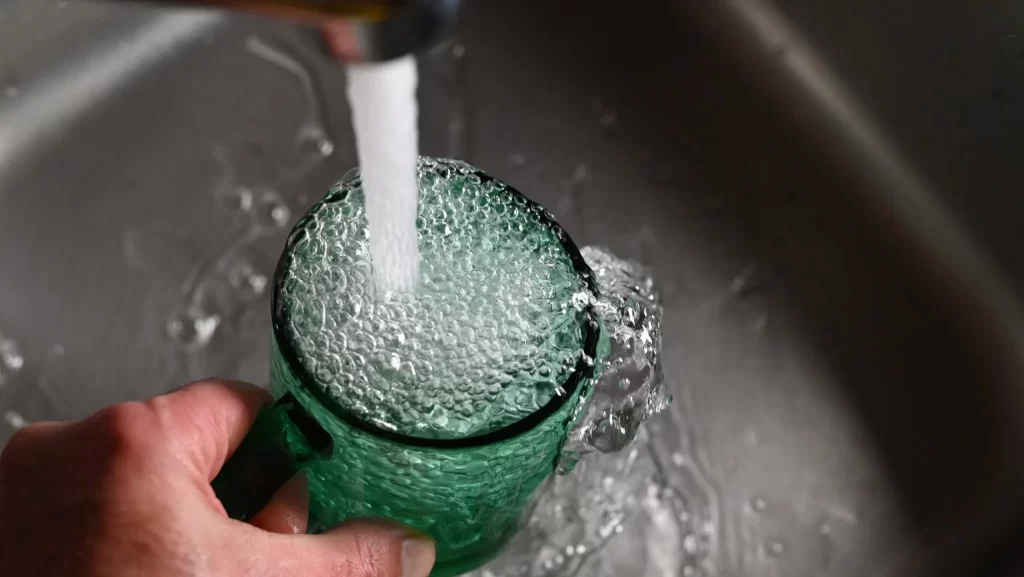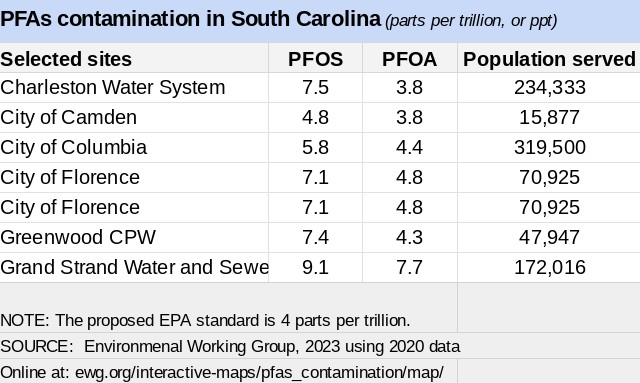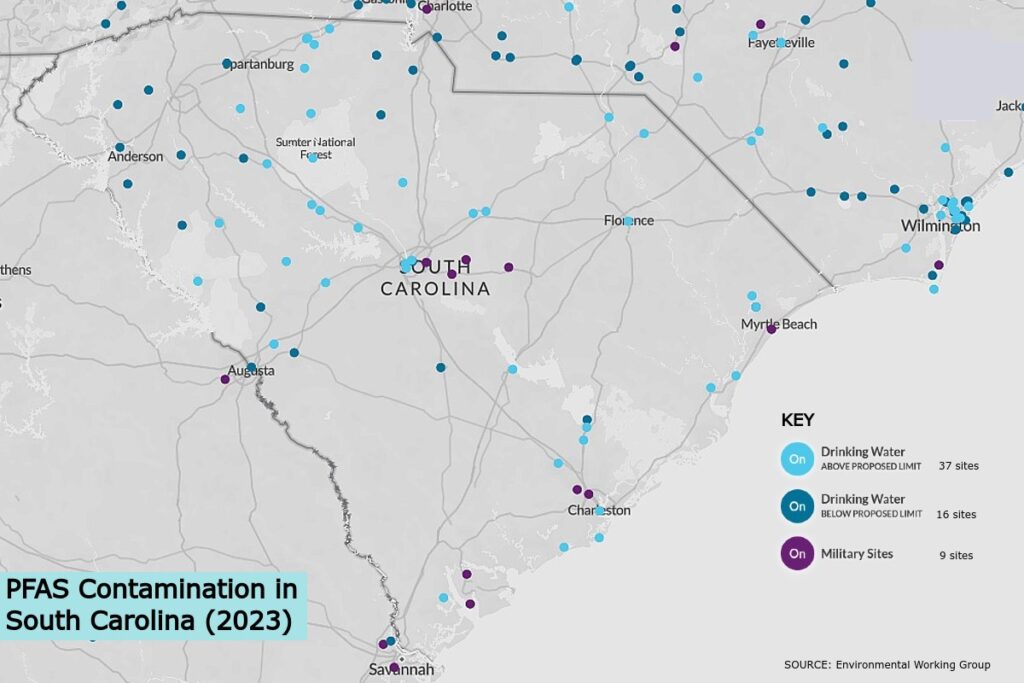
Staff reports | If you’ve ever wondered whether there’s something in the water, well, there is.
All across the Palmetto state, drinking water in 37 water utilities has levels of so-called forever chemicals, technically known as PFAs or “per- and poly-fluoroalkyl substances,” that are higher than a proposed federal standard, according to a study by the national nonprofit Environmental Working Group. [See map.]
People across the country are being exposed to these chemicals every day in the environment and tap water, despite not knowing “the long-term effects of a lot of these chemicals,” said Jared Hayes, senior EWP policy analyst at the group’s Washington, D.C. office. “The [American] public is essentially being used as guinea pigs,” he added.
PFAs are used to resist “grease, oil, water and heat,” according to the U.S. Food and Drug Administration. PFAs can be found in household items like rain jackets and non-stick cookware, and they are highly concentrated in firefighting foam, or AFFF. They’re colloquially known as “forever chemicals” because of their almost indestructible properties.
Right now, there is no federal standard for PFAs in drinking water. Some states have their own regulations, but South Carolina does not. But earlier this year, the U.S. Environmental Protection Agency proposed a national standard for an enforceable Maximum Contaminant Level (MCL) of 4 parts per trillion (ppt) for PFOS and PFOA, though the Maximum Contaminant Level Goal (MCLG) — defined as “the maximum level of a contaminant in drinking water where there are no known or anticipated negative health effects allowing for a margin of safety” — is 0 ppt for both. An MCL is the “maximum level allowed” and should be “as close as feasible to the MCLG, according to the agency.
If the new regulation were to become a reality, drinking water measurements from at least 37 of the state’s water utilities would be above the MCL, which means action likely would be required to reduce contamination, according to the EWG study.
 A chart at right shows representative PFOS and PFOA levels for seven of the state’s largest water utilities.
A chart at right shows representative PFOS and PFOA levels for seven of the state’s largest water utilities.
“Safe to drink”
In Charleston, for example, drinking water is safe, despite the presence of PFAs, said Charleston Water System (CWS) spokesman Mike Saia.
“We believe 100% that our water is safe to drink,” he said. “If people are considering using a filter, we try to inform them to make that decision by publishing an annual water report, which is easily accessible on our website.”
In May, the utility, which serves about a half million people in the Charleston area, reported concentrations of two PFA subtypes (PFOS and PFOA) at 4.2 ppt and 5.2 ppt, respectively, in its drinking water.
CWS Board Chair Thomas Pritchard told the Charleston City Paper that the agency “started testing for those things before most utilities in the country did, and we’ve been on top of it all along.”

Ongoing litigation
Concerns about PFAs have recently received more attention because a Charleston federal courtroom is the site of major national litigation over forever chemicals. U.S. District Judge Richard Gergel has been presiding over and managing a large number of related water pollution cases. More than 5,000 plaintiffs have filed PFAs-related lawsuits, according to news reports.
In a 2021 complaint at the U.S. District Court in Charleston, former U.S. Navy firefighter Michael Sloane of Spring, Texas, alleged that his exposure to firefighting foam, or AFFF, at military installations, including the Charleston Naval Base, was “directly and proximately” to blame for his testicular cancer.
Plaintiffs are seeking damages from major PFAs producers, such as 3M and Dupont, for allegedly knowing about the harms their chemicals would cause to individuals, property, natural resources and drinking water.
So far, there have been two major recent settlements. They include a tentative $10.3 billion to $12.5 billion in damages from 3M and a $1.185 billion from Dupont to public water suppliers nationwide. Both settlements still require court approval.
CWS’s Pritchard said the utility’s water treatment and wastewater treatment facilities were plaintiffs in the litigation that was suing PFAs makers because “we recognize that the cost going forward for treatment and future impacts is significant.”
There’s also a separate statewide lawsuit filed by S.C. Attorney General Alan Wilson. The complaint is pursuing legal action against companies like 3M and Dupont for allegedly having “misled the public” about the harmful effects of PFAs. Documents from EWG show manufacturers knew PFAs “posed health risks” as early as the 1960s — and many are still producing them.
But with this suit, there is a caveat that might impact plaintiffs like Sloane, the firefighter: The state’s lawsuit “expressly excludes…contamination or injury related to AFFF or AFFF products.” AFFF is the “primary source of PFAs at military installations,” according to EWG. But it reported the Department of Defense (DoD) also knew that PFAs might be dangerous — and as early as the 1970s. Until the AFFF completes its phase-out by October 2023, some firefighters are continuing to use it, according to one news report.
Huge cleanup costs
EWG’s Hayes noted it won’t be cheap to clean up water with levels of PFAs that are unsafe, if the proposed standard is approved. The billions of dollars in tentative settlements by 3M and Dupont are just “a drop in the bucket” needed by municipalities across the country to eliminate PFAs from their drinking water and wastewater treatment. For example, Saia said that it would “cost hundreds of millions of dollars” to bring Charleston’s drinking water below the proposed 4 ppt standard.
Time is playing a role in the results of the lawsuits in federal court. In an interview with the Charleston City Paper, attorney Joe Rice of Mount Pleasant-based law firm Motley Rice spoke of a program set up to “medically monitor [PFAs plaintiffs] as time goes forward, because [the diseases linked to PFAs exposure] are latent diseases.” Nonetheless, one study of air servicemen in mid-August confirmed what Sloane alleged all along — a link between exposure to some PFAs in AFFF and testicular cancer.
Andy Brack contributed to this story by reporter Lily Levin of the Charleston City Paper, which published an earlier version. Comment? Send to: feedback@charlestoncitypaper.com















 We Can Do Better, South Carolina!
We Can Do Better, South Carolina!
I recently read an article in the state newspaper about an abandoned
Denim processing site just off the broad river, with retention ponds
Containing PFAS/Pfos chemicals. This site is above the Columbia Canal where Columbiaobtains it source of water for our drinking water. I’m concerned that no measures are being taken to preserve the safety of our drinking water. Britta. Filters are not effective. How can Columbians
Protect themselves? Reverse osmosis filtration is expensive. Can I trust
My local Government to protect us?